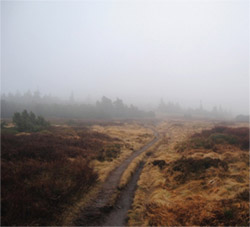
In L'Occhio Del Vedere, Giovanni Di Domenico (piano), Silvia Tarozzi (violin, 1/16th tone violin) and Emmanuel Holterbach (large frame drum) combine to create a soundscape that endures for just over an hour. This album has two notable features. Firstly, it has a triptych structure: the three instruments can be appreciated both individually and collectively. And, secondly, it consists of repeating melodies that only change with respect to their texture. These noteworthy features combine to reveal just how delicate the concept of melody is. This album illustrates how microtonal changes determine whether there is consonance or dissonance.
The landscape of this album is parsimonious to say the least: it is sparse, barren and windswept. However, just as with any landscape, life still persists, somewhere, buried away in some nook or cranny. Hiding out of sight, Di Domenico's piano gently lifts its head out of its burrow to inspect the scene. And, after satisfying itself that the coast is clear, it begins to romp around, kicking up dust as it goes. Perhaps because of all this commotion, Tarozzi's violin eventually slithers into the scene to see what all the fuss is about. Elated by the fact that they are not alone, the two instruments begin a discursive conversation. This exchange oscillates from free flowing to downright awkward. Regardless, the conversation continues. But, as always, things must come to an end. With grins stretching from ear to ear, the two instruments retreat back to their respective dens. Maybe they will do it all over again soon.
Di Domenico has said that, L'Occhio Del Vedere, '[W]e tried to find the perfect balance of tension and release, of consonance and dissonance...' This album certainly realizes this collective intention; there are very few places where you can hear music which is energetic and yet patient, melodic and yet disharmonious, and free-flowing and yet meticulously thought out.
Comments and Feedback:



More Recent Reviews, Articles, and Interviews @ The Squid's Ear...


|

